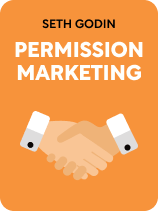

This article is an excerpt from the Shortform book guide to "Permission Marketing" by Seth Godin. Shortform has the world's best summaries and analyses of books you should be reading.
Like this article? Sign up for a free trial here.
What’s the best way to approach prospective customers? What’s the most profitable level of permission you can get from customers?
In Permission Marketing, Seth Godin establishes the broad basics of his approach: Make long-term investments in your customers, and personalize offers for each individual. Then, he gets more specific and outlines the steps you can take to set up and profit from a permission marketing campaign.
Keep reading to learn the basics of Seth Godin’s marketing strategy as presented in Permission Marketing.
Seth Godin’s Marketing Strategy From Permission Marketing
The first step in Seth Godin’s marketing strategy is opening a line of communication with consumers by offering them valuable freebies in exchange for their contact information. Then, gain their trust by pitching them the benefits they can expect if they purchase from your brand. Finally, leverage the trust you gain from messaging consumers to implement one or more profitable business models.
Let’s inspect each step in more detail.
Step #1: Open Communication by Giving Out Freebies
Your first goal when starting a permission marketing campaign is to get consumers’ permission to send information about your brand directly to them. Godin acknowledges that permission marketers must initially resort to Interruption Marketing to make first contact with consumers and request their permission for later marketing materials. This initial advertising isn’t meant to build brand trust—just to attract consumers to the messages that will. Run advertisements that direct consumers to your permission marketing channel—for instance, a YouTube advertisement telling viewers to sign up for your email list.
To incentivize consumers to give you their permission to contact them, use your initial Interruption Marketing to offer them something valuable for free in exchange for their contact information. Even if consumers are only slightly interested in your brand, if the reward you offer is enticing enough, they’ll give you permission to contact them again. In follow-up communications, you can give them more information about your product or service to heighten their interest.
The freebies you offer consumers could be anything—a free sample of your product, helpful and practical information, or just a link to a fun video you’ve created. The important thing is to design these freebies to attract the target audience to whatever product or service you’re selling. For example, if you’re selling incense, you may offer a guide to the most popular incense scents and their traditional symbolic meanings for free.
Step #2: Build Trust by Pitching Your Product or Service
After you secure permission to contact consumers directly, your goal is to use that communication channel to build their trust in your brand. Godin suggests sending consumers a series of marketing messages that convey specifically how your brand will improve their life.
Make sure consumers don’t lose interest in these messages, Godin notes. Each one should provide enough value (such as entertainment or useful information) to retain their attention. If consumers need more encouragement, provide additional freebies as necessary to keep them engaged.
Step #3: Establish a Trust-Based Business Model
Once consumers strongly believe that your brand can improve their lives, you unlock a number of profitable business models that function only after you’ve earned consumer trust. Here are three options for trust-based business models with the potential to turn your company into a wild success.
Option #1: Sign Customers Up for a Subscription
According to Godin, the most valuable form of permission you can get is to charge the customer for goods and services you know they want, without them giving specific permission for each purchase—typically, this takes the form of a recurring subscription payment. If consumers trust that you understand what they want and can reliably give it to them, they’ll gladly pay you to buy things for them to avoid wasting time doing it themselves. All permission marketers should aspire to achieve this level of permission since it’s the most profitable.
Option #2: Implement a Rewards Program
If you can’t establish a subscription model, the next most valuable form of permission you can get is permission to influence consumers’ behavior in exchange for points that earn them free rewards. Godin recommends offering points for every purchase as well as for actions that increase the likelihood of future purchases—for instance, a customer engaging with a branded message to learn more about your product or service.
Rewards programs increase profits by incentivizing consumers to purchase from your brand more frequently than they otherwise would have—in other words, by bribing people to become loyal customers. With this in mind, Godin recommends a specific way to structure your rewards: To ensure that only customers who are truly loyal to your brand get rewarded, make your points worthless if consumers interact with your brand once or twice but pay off if they become regular customers. That way, you only invest money in already-profitable customers.
Option #3: Sell High-Ticket Items Personally
Finally, another option for establishing a profitable, trust-based business model is to reach out, set up meetings with individual consumers, and get to know them personally. If someone trusts you on a personal level, you can get them to invest much more in you and your brand than if you contacted them through an impersonal system. That said, Godin acknowledges that the utility of this business model is limited since it requires significant personal attention that you can’t provide to a wide customer base. Thus, use only personal trust to sell expensive goods and services that provide enough revenue to justify your prolonged personal time and attention.
Exercise: What Permission Have You Given?
Reflect on the permission marketing campaigns you encounter to gain a deeper understanding of how the strategy works. Then, use this reflection as inspiration to design your own permission marketing campaign.
- List a few permission marketing channels you subscribe to as a consumer. (For example, you may regularly receive emails from your local movie theater advertising upcoming events, follow an Instagram account that posts photos from an online travel magazine, and get push notifications from the app for your favorite fast food restaurant alerting you to limited-time offers.)
- Think back to the time you initially signed up to receive each of these permission marketing messages. What freebies or other incentives did the brands give you in exchange? (For example, the fast food app may have given you a free meal for downloading it.)
- What incentives did the brands give you to keep receiving messages? How did this repeated marketing influence or change your behavior? (For example, the fast food app may allow you to earn points redeemable for free food every time you watch an advertisement or make a purchase. Perhaps this influenced you to habitually eat there once a week after going to the gym.)
- Using these examples as inspiration, design a hypothetical permission marketing campaign of your own. Pick a business, plan incentives, and identify how you want to influence consumers’ behavior. (For example, if you want to sell custom jewelry, you may offer an exclusive one-time discount to people who sign up for your email list and send them photos of your most interesting custom work to get them to continue reading your emails. You hope this will get them to purchase a full-price piece from you the next time they need to give a gift.)

———End of Preview———
Like what you just read? Read the rest of the world's best book summary and analysis of Seth Godin's "Permission Marketing" at Shortform.
Here's what you'll find in our full Permission Marketing summary:
- Why common intrusive marketing methods don't work well anymore
- How to build a loyal customer base that wants to see your marketing
- Three steps to building and profiting from a permission marketing campaign






